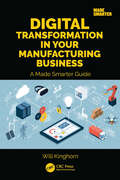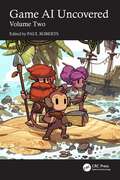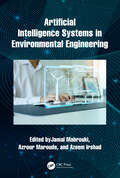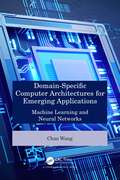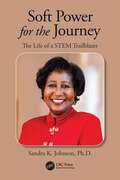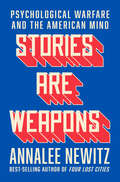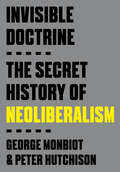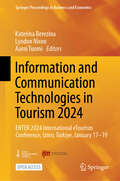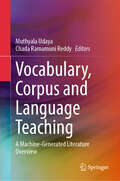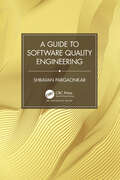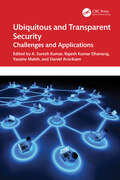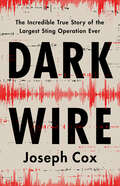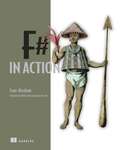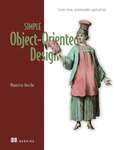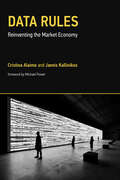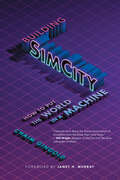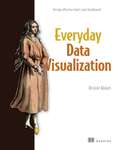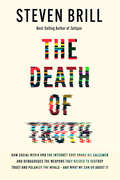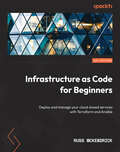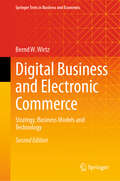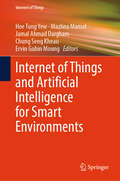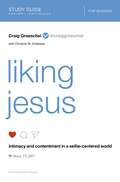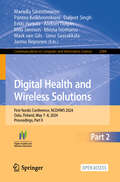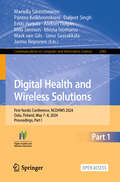- Table View
- List View
Digital Transformation in Your Manufacturing Business: A Made Smarter Guide
by Will KinghornAre you a manufacturing leader and unsure of which technology can help grow your business? Have you heard about 3D printing, Industry 4.0, robots, or artificial intelligence but don’t know how they can be used in manufacturing?This book gives a clear and practical guide to manufacturing technologies, providing examples of how they’re used, as well as the tools and techniques you’ll need to get started. Each technology is covered in a brief and simple way allowing you to understand it quickly and decide if it’s worth investigating for your business.In addition to this book, the online resources will provide you with templates and examples to help you get started. At every stage there are suggestions for the key terms you will need to find more information appropriate to your industry.This isn’t just about technology, it’s a roadmap for your digital transformation. Start with guidance on setting your company’s vision and direction, to getting the people in your business engaged and ready to adopt technology. Move on to exploring each of the technologies, and the tools and techniques you’ll find useful along the way. Finally, connect the technologies with the tools that are appropriate, and look at common issues in manufacturing businesses and how these can be resolved.Get started with making informed decisions, embracing technologies, and transforming your business.
Game AI Uncovered: Volume Two
by Paul Roberts Nicholas DentGame AI Uncovered: Volume Two continues the series with the collected wisdom, ideas, tricks and cutting‑edge techniques from 22 of the top game AI professionals and researchers from around the world.The techniques discussed in these pages cover the underlying development of a wide array of published titles, including The Survivalists, Wheelman, Plants vs. Zombies: Battle for Neighborville, Dead Space, Zombie Army 4, Evil Genius 2, Sniper Elite 5, Sonic & All‑Stars Racing Transformed, DiRT: Showdown, and more.Contained within this volume are overviews and insights covering a host of different areas within game AI, including generalised planners, player imitation, awareness, dynamic behaviour trees, decision‑making architectures, agent learning for automated playthroughs, utility systems, machine learning for cinematography, directed acyclic graphs, environment steering, difficulty scenarios, environmental cues through voxels, automated testing approaches, dumbing down your AI, synchronized path following, and much more.Beginners to the area of game AI, along with professional developers, will find a wealth of knowledge that will not only help in the development of your own games but also spark ideas for new approaches.This volume includes chapters written by Nuno Vicente Barreto, Steve Bilton, Andy Brown, Dr Allan Bruce, Richard Bull, Phil Carlisle, Sarah Cook, Michele Condò, Steven Dalton, Rodolfo Fava, Jonas Gillberg, Dominik Gotojuch, Dale Green, Tobias Karlsson, Jonathan Keslake, Fernando Penousal Machado, Ivan Mateev, Dr Nic Melder, Dr Bram Ridder, Paul Roberts, Licínio Roque, and Andrea Schiel.
Artificial Intelligence Systems in Environmental Engineering
by Azeem Irshad Jamal Mabrouki Azrour MaroudeSpecialists are paying attention to the growing concern for environmental issues. Artificial Intelligence Systems in Environmental Engineering uses techniques from the field of Artificial Intelligence as the alternative to address problems that are difficult to model by analytical methods. The book provides a general study and introduces a set of techniques for environmental engineering. With a particular focus on climate change and energy policy, it discusses innovative solutions and models that can positively influence and increase the efficiency of resource use and decrease the impact on the environment while developing the well-being of individuals. The book will be of most interest to research students who have a scientific approach and deal with problems related to environmental engineering.
Domain-Specific Computer Architectures for Emerging Applications: Machine Learning and Neural Networks
by Chao WangWith the end of Moore’s Law, domain-specific architecture (DSA) has become a crucial mode of implementing future computing architectures. This book discusses the system-level design methodology of DSAs and their applications, providing a unified design process that guarantees functionality, performance, energy efficiency, and real-time responsiveness for the target application.DSAs often start from domain-specific algorithms or applications, analyzing the characteristics of algorithmic applications, such as computation, memory access, and communication, and proposing the heterogeneous accelerator architecture suitable for that particular application. This book places particular focus on accelerator hardware platforms and distributed systems for various novel applications, such as machine learning, data mining, neural networks, and graph algorithms, and also covers RISC-V open-source instruction sets. It briefly describes the system design methodology based on DSAs and presents the latest research results in academia around domain-specific acceleration architectures.Providing cutting-edge discussion of big data and artificial intelligence scenarios in contemporary industry and typical DSA applications, this book appeals to industry professionals as well as academicians researching the future of computing in these areas.
Soft Power for the Journey: The Life of a STEM Trailblazer
by Sandra K. JohnsonThis is a story of an African American woman working at the highest levels in STEM. Dr. Sandra K. Johnson earned a Ph.D. in electrical and computer engineering from Rice University, Houston, Texas, in May 1988, the first Black woman to do so. She then became a successful global technology leader and an IBM Chief Technology Officer (CTO). The story narrates the inextricable human dimension of dealing with various personal and familial challenges that people naturally encounter—with the highs and lows, and exhilarations and disappointments. It portrays her inner strength, persistence, dedication, boldness, quiet resilience, wisdom and strong faith, this soft power she leverages throughout her life. It is a heartwarming, compelling story designed to encourage, be aspirational and awe-inspiring, and uplift the spirits of a broad and diverse readership.From tragically losing her father at the age of two, to being raised by a single mother of four children, Sandra showed promise in math and science, and discipline and unrelenting drive at a young age. Raised in the deep South, she exhibited leadership even while in kindergarten and blazed trails in leadership while in junior high and high schools. Her early education was in segregated schools, with integration coming to her hometown as she started the 5th grade. Dr. Johnson’s innate abilities led her to a summer engineering program for high school students, then on to college and graduate school.Dr. Johnson has made innovative contributions in high performance computing – supercomputers – and other areas of computer engineering. She has dozens of technical publications, over 45 pending and issued patents, and a plethora of recognition and honors in her field. The book is a fascinating and intriguing story that conveys in captivating and relatable ways the remarkable life arc of a resilient person from an underprivileged background who persistently overcomes whatever odds and challenges are encountered in her life. It is a riveting human tale of a triumphant spirit, moving forward with soft power to celebrate achievement and handle obstacles with steel willpower, influential support, and faith.Access the authors' webpage here https://softpowerforthejourney.com/
Stories Are Weapons: Psychological Warfare and the American Mind
by Annalee NewitzOne of Publishers Weekly's Top 10 Politics/Current Events books of Spring 2024 A sharp and timely exploration of the dark art of manipulation through weaponized storytelling, from the best-selling author of Four Lost Cities. In Stories Are Weapons, best-selling author Annalee Newitz traces the way disinformation, propaganda, and violent threats—the essential tool kit for psychological warfare—have evolved from military weapons deployed against foreign adversaries into tools in domestic culture wars. Newitz delves into America’s deep-rooted history with psychological operations, beginning with Benjamin Franklin’s Revolutionary War–era fake newspaper and nineteenth-century wars on Indigenous nations, and reaching its apotheosis with the Cold War and twenty-first-century influence campaigns online. America’s secret weapon has long been coercive storytelling. And there’s a reason for that: operatives who shaped modern psychological warfare drew on their experiences as science fiction writers and in the advertising industry. Now, through a weapons-transfer program long unacknowledged, psyops have found their way into the hands of culture warriors, transforming democratic debates into toxic wars over American identity. Newitz zeroes in on conflicts over race and intelligence, school board fights over LGBT students, and campaigns against feminist viewpoints, revealing how, in each case, specific groups of Americans are singled out and treated as enemies of the state. Crucially, Newitz delivers a powerful counternarrative, speaking with the researchers and activists who are outlining a pathway to achieving psychological disarmament and cultural peace. Incisive and essential, Stories are Weapons reveals how our minds have been turned into blood-soaked battlegrounds—and how we can put down our weapons to build something better.
Invisible Doctrine: The Secret History of Neoliberalism
by George Monbiot Peter HutchisonWe live under an ideology that preys on every aspect of our lives: our education and our jobs; our healthcare and our leisure; our relationships and our mental well-being; the planet we inhabit—the very air we breathe. It is everywhere. Yet for most people, it has no name. It seems inescapable, like a natural law.But trace it back to its roots, and you see that this ideology is neither inevitable nor immutable. It was conceived and propagated—and then concealed—by the powerful few. Our task is to bring it into the light—and to build a new system that is worth fighting for. Neoliberalism.Do you know what it is?
Information and Communication Technologies in Tourism 2024: ENTER 2024 International eTourism Conference, Izmir, Türkiye, January 17-19 (Springer Proceedings in Business and Economics)
by Lyndon Nixon Katerina Berezina Aarni TuomiFor more than 30 years, Information and Communication Technology (ICT) has been revolutionizing travel, tourism, and hospitality, and as we look to the next 30 years, the change of pace does not seem to be diminishing. This open-access book provides an extensive overview of the latest developments of ICTs in the tourism and hospitality industry. Featuring papers presented at the International Federation for IT and Travel & Tourism’s (IFITT) 31st annual ENTER International eTourism Conference (ENTER24) held in Izmir, Türkiye, this book presents research on topics such as artificial general intelligence (AGI) in tourism and hospitality; emerging technologies in tourism education; virtual reality; technologies for sustainability, health and wellbeing; big data and analytics, among others. This is an open access book.
Vocabulary, Corpus and Language Teaching: A Machine-Generated Literature Overview
by Muthyala Udaya Chada Ramamuni ReddyThis book is the result of a collaboration between a human editor and an artificial intelligence algorithm to create a machine-generated literature overview of research articles analyzing the importance of ESL/EFL vocabulary and corpus studies. It is a new publication format in which state-of-the-art computer algorithms are applied to select the most relevant articles published in Springer Nature journals and create machine-generated literature reviews by arranging the selected articles in a topical order and creating short summaries of these articles.This comprehensive book explores ESL/EFL vocabulary and corpus studies from five main perspectives: acquisition, strategies, ICT, corpus, and current practices. The sections delve into topics such as the impact of technology on learning, the power of corpora in language education, and innovative vocabulary-development techniques.This book is an essential resource for researchers, educators, and language facilitators seeking a deeper understanding of vocabulary within ESL/EFL teaching and learning contexts.
A Guide to Software Quality Engineering
by Shravan PargaonkarIn today’s fast-paced digital world, delivering high-quality software is not just a goal; it’s an absolute necessity. A Guide to Software Quality Engineering is a companion book for anyone involved in software development, testing, or quality assurance.This comprehensive book takes you on a transformative journey through the world of software quality engineering, providing invaluable insights, practical methodologies, and expert advice that will elevate your projects to new levels of excellence.The book features the following points:• Performance Testing Security Testing• Usability Testing• Continuous Integration and Continuous Testing• Requirements Engineering and Quality• Code Quality and Static Analysis• Defect Management and Root Cause Analysis• Release and Deployment ManagementDive into the fundamental principles of software quality engineering, understanding the critical role it plays in ensuring customer satisfaction, user experience, and the overall success of your software products. Whether you’re a seasoned professional or a budding enthusiast, this book caters to all levels of expertise.
Ubiquitous and Transparent Security: Challenges and Applications
by Yassine Maleh Rajesh Kumar Dhanaraj A. Suresh Kumar Daniel ArockiamIn an increasingly interconnected digital realm, Ubiquitous and Transparent Security: Challenges and Applications emerges as a guiding beacon through the intricate web of modern cybersecurity. This comprehensive tome meticulously dissects the multifaceted challenges faced in safeguarding our digital infrastructure. From the omnipresence of threats to the evolving landscape of vulnerabilities, this book navigates the complexities with a keen eye, offering a panoramic view of the security terrain.Drawing on a rich tapestry of insights from leading experts, this book transcends the traditional boundaries of security discourse. It unveils innovative strategies and technologies, illuminating the path toward a future where security seamlessly integrates with the fabric of our digital existence. With a keen focus on transparency, it delves deep into the mechanisms that enable a clear, holistic view of security, empowering stakeholders to navigate this dynamic landscape with confidence.From cutting-edge applications to the ethical considerations of ubiquitous security, each chapter acts as a guiding compass, providing actionable insights and fostering a deeper understanding of the intricate balance between accessibility and protection. Ubiquitous and Transparent Security is not merely a book; it’s a roadmap for practitioners, policymakers, and enthusiasts alike, navigating the ever-evolving world of cybersecurity.Each chapter within this compendium illuminates the diverse challenges that confront security practitioners, policymakers, and technologists today. It goes beyond the conventional paradigms, exploring the nuanced intersections between accessibility, transparency, and robust protection. Through a rich amalgamation of research-backed insights, real-world case studies, and visionary forecasts, this book offers a holistic understanding of the evolving threat landscape, empowering stakeholders to fortify their defenses proactively.
Dark Wire: The Incredible True Story of the Largest Sting Operation Ever
by Joseph CoxThe inside story of the largest law-enforcement sting operation ever, in which the FBI made its own tech start-up to wiretap the world, shows how cunning both the authorities and drug traffickers have become, with privacy implications for everyone. In 2018, a powerful app for secure communications called Anom took root among organized criminals. They believed Anom allowed them to conduct business in the shadows. Except for one thing: it was secretly run by the FBI. Backdoor access to Anom and a series of related investigations granted American, Australian, and European authorities a front-row seat to the underworld. Tens of thousands of criminals worldwide appeared in full view of the same agents they were trying to evade. International smugglers. Money launderers. Hitmen. A sprawling global economy as efficient and interconnected as the legal one. Officers watched drug shipments and murder plots unfold, making arrests without blowing their cover. But, as the FBI started to lose control of Anom, did the agency go too far? A painstakingly investigated exposé, Dark Wire reveals the true scale and stakes of this unprecedented operation through the agents and crooks who were there. This fly-on-the-wall thriller is a caper for our modern world, where no one can be sure who is listening in.
F# in Action (In Action)
by Isaac AbrahamF# is engineered to make functional programming practical and accessible. This book will get you started writing your first simple, robust, and high performing functional code.F# lets you keep your code simple even in the most complex applications—and it&’s the perfect language for taking your first steps in functional programming. This practical, example-driven guide shows you how to build professional applications the F# way. In F# in Action you will learn how to: Write performant and robust systems with succinct F# code Model domains quickly, easily and accurately with F#&’s type system Design solutions using functional programming patterns Ingest and process disparate data sources Develop data-driven web applications Unit test F# code Effectively model data using a variety of techniques Use scripts to rapidly explore domains F# in Action is based on author and Microsoft F# MVP Isaac Abraham&’s years of experience working with developers as an F# consultant. It upgrades .NET development skills with the core principles of functional programming, and you&’ll soon see how F#&’s functional-first approach makes it easy to learn this powerful paradigm. Forewords by Phillip Carter and Tomas Petricek. About the technology F# is a uniquely powerful programming language. Its &“light touch&” approach to functional programming helps you deliver error-free code without a lot of complex math and academic theory. Simply put, F# exists to help you write better software faster, and this book will show you how. About the book F# in Action teaches you to write professional quality applications in F#. For each concept, feature, and technique you&’ll find hands-on examples, starting with simple data transformations and progressing all the way to a full-size web app. Throughout the book, you&’ll take advantage of battle-tested .NET tools to take on a wide range of tasks—from data analysis to interoperability with C#. What's inside Model domains with F#&’s type system Ingest and process disparate data sources Unit test F# code Use scripts to rapidly explore domains About the reader For readers comfortable with any OO or FP language. Prior .NET knowledge not required! About the author Isaac Abraham is an experienced .NET developer, trainer, and Microsoft MVP for his contributions to the .NET community. Technical editor on this book was Michael Ciccotti. Table of Contents 1 Introducing F# 2 Hands on with F# 3 F# Syntax Basics 4 F# Fundamentals 5 Shaping data 6 Functions and modules 7 Working with collections 8 Patterns and unions 9 Building rich domains 10 Working effectively with data 11 F# Interop 12 Asynchronous programming 13 Web programming 14 Testing F# code 15 Pure functional programming 16 Where next?
Simple Object-Oriented Design: Create clean, maintainable applications
by Mauricio AnicheWrite object-oriented code that&’s manageable, maintainable, and future-proof.Keeping your object-oriented designs simple demands a creative approach—and that&’s exactly what you&’ll find in Simple Object-Oriented Design. This book is full of patterns and principles for reducing complexity, each one proven in author Mauricio Aniche&’s 20-year career in software development. You&’ll learn how to tackle code&’s natural growth in complexity, and adopt a &“good enough&” approach that means it&’s easy to refactor when requirements change. You&’ll discover insightful principles for: Making code readable and documented Improving consistency and encapsulation Managing dependencies Designing abstractions Handling infrastructure Effective modularization Learn what constitutes both good and bad object-oriented software design, discover how to make better trade-offs in design decisions, and when to embrace complexity over simpler data structures. With this book as your vital reference, you&’ll be ready to write code that will last the test of time, without slowing feature delivery to a crawl. About the technology Even a simple object-oriented application can quickly become complex as it evolves. Each new class, method, or feature means more state and abstractions to manage, which in turn increases complexity, maintenance, and time spent detangling legacy code. It takes effort and skill to keep your codebase simple. This book shows you how. About the book Simple Object-Oriented Design: Create clean, maintainable applications presents practical design principles you can use to keep an object-oriented codebase simple as it grows and changes. Written as a collection of practical techniques you can apply in any OO language, it offers tips for concise code, managing dependencies and modules, and designing flexible abstractions. Illuminating figures, real-world examples, and insightful exercises make each principle stick. What's inside Writing simple, understandable classes Flexible abstractions to extend your designs Reducing the impact of coupling About the reader Readers should be familiar with an object-oriented language like Java, C#, or Python. About the author Maurício Aniche is a software engineer with 20 years of experience. He&’s also an Assistant Professor in Software Engineering at Delft University of Technology, and the author of Effective Software Testing. Table of Contents 1 It&’s all about managing complexity 2 Making code small 3 Keeping objects consistent 4 Managing dependencies 5 Designing good abstractions 6 Handling external dependencies and infrastructure 7 Achieving modularization 8 Being pragmatic
Data Rules: Reinventing the Market Economy (Acting with Technology)
by Jannis Kallinikos Cristina AlaimoA new social science framework for studying the unprecedented social and economic restructuring driven by digital data.Digital data have become the critical frontier where emerging economic practices and organizational forms confront the traditional economic order and its institutions. In Data Rules, Cristina Alaimo and Jannis Kallinikos establish a social science framework for analyzing the unprecedented social and economic restructuring brought about by data. Working at the intersection of information systems and organizational studies, they draw extensively on intellectual currents in sociology, semiotics, cognitive science and technology, and social theory. Making the case for turning &“data-making&” into an area of inquiry of its own, the authors uncover how data are deeply implicated in rewiring the institutions of the market economy.The authors associate digital data with the decentering of organizations. As they point out, centered systems make sense only when firms (and formal organizations more broadly) can keep the external world at arm&’s length and maintain a relative operation independence from it. These patterns no longer hold. Data transform the production of goods and services to an endless series of exchanges and interactions that defeat the functional logics of markets and organizations. The diffusion of platforms and ecosystems is indicative of these broader transformations. Rather than viewing data as simply a force of surveillance and control, the authors place the transformative potential of data at the center of an emerging socioeconomic order that restructures society and its institutions.
Building SimCity: How to Put the World in a Machine (Game Histories)
by Chaim GingoldA deep dive into the trailblazing simulation game SimCity, situating it in the history of games, simulation, and computing.Building SimCity explores the history of computer simulation by chronicling one of the most influential simulation games ever made: SimCity. As author Chaim Gingold explains, Will Wright, the visionary designer behind the urban planning game, created SimCity in part to learn about cities, appropriating ideas from traditions in which computers are used as tools for modeling and thinking about the world as a complex system. As such, SimCity is a microcosm of the histories and cultures of computer simulation that engages with questions, themes, and representational techniques that reach back to the earliest computer simulations.Gingold uses SimCity to explore a web of interrelated topics in the history of technology, software, and simulation, taking us far and wide—from the dawn of programmable computers to miniature cities made of construction paper and role-play. An unprecedented history of Maxis, the company founded to bring SimCity to market, the book reveals Maxis&’s complex relations with venture capitalists, Nintendo, and the Santa Fe Institute, which shaped the evolution of Will Wright&’s career; Maxis&’s failure to back The Sims to completion; and the company&’s sale to Electronic Arts.A lavishly visual book, Building SimCity boasts a treasure trove of visual matter to help bring its wide-ranging subjects to life, including painstakingly crafted diagrams that explain SimCity&’s operation, the Kodachrome photographs taken by Charles Eames of schoolchildren making model cities, and Nintendo&’s manga-style &“Dr. Wright&” character design, just to name a few.
Everyday Data Visualization: Design effective charts and dashboards
by Desireé AbbottRadically improve the quality of your data visualizations by employing core principles of color, typography, chart types, data storytelling, and more.Everyday Data Visualization is a field guide for design techniques that will improve the charts, reports, and data dashboards you build every day. Everything you learn is tool-agnostic, with universal principles you can apply to any data stack. In Everyday Data Visualization you&’ll learn important design principles for the most common data visualizations: Harness the power of perception to guide a user&’s attention Bring data to life with color and typography Choose the best chart types for your data story Design for interactive visualizations Keep the user&’s needs first throughout your projects This book gives you the tools you need to bring your data to life with clarity, precision, and flair. You&’ll learn how human brains perceive and process information, wield modern accessibility standards, get the basics of color theory and typography, and more. About the technology Even mundane presentations like charts, dashboards, and infographics can become engaging and inspiring data stories! This book shows you how to upgrade the visualizations you create every day by improving the layout, typography, color, and accessibility. You&’ll discover timeless principles of design that help you highlight important features, compensate for missing information, and interact with live data flows. About the book Everyday Data Visualization guides you through basic graphic design for the most common types of data visualization. You&’ll learn how to enhance charts with color, encourage users to interact and explore data and create visualizations accessible to everyone. Along the way, you&’ll practice each new skill as you take a dashboard project from research to publication. What's inside Bring data to life with color and typography Choose the best chart types for your data story Design interactive visualizations About the reader For readers experienced with data analysis tools. About the author Desireé Abbott has over a decade of experience in product analytics, business intelligence, science, design, and software engineering. The technical editor on this book was Michael Petrey. Table of Contents PART 1 1 Hello, data viz! 2 How we perceive information 3 It&’s all about the data PART 2 4 Choosing colors 5 Typography 6 Creating a good chart 7 Designing for interactivity PART 3 8 Research, design, and development 9 Troubleshooting Appendix
The Death of Truth: How Social Media and the Internet Gave Snake Oil Salesmen and Demagogues the Weapons They Needed to Destroy Trust and Polarize the World--And What We Can Do
by Steven BrillHow did we become a world where facts—shared truths—have lost their power to hold us together as a community, as a country, globally? How have we allowed the proliferation of alternative facts, hoaxes, even conspiracy theories, to destroy our trust in institutions, leaders, and legitimate experts? Best-selling journalist Steven Brill documents the forces and people, from Silicon Valley to Madison Avenue to Moscow to Washington, that have created and exploited this world of chaos and division—and offers practical solutions for what we can do about it."A precise description of the punishment cell we have built around our minds and the first few steps back towards light and air." –Timothy Snyder, Author of On Tyranny and Professor of History, Yale University&“A seminal, ground-breaking, documented and honest examination of two of the central dilemmas of our time—what is truth and where to find it.&” —Bob Woodward, associate editor at The Washington PostAs the cofounder of NewsGuard, a company that tracks online misinformation, Steven Brill has observed the rise of fake news from a front-row seat. In The Death of Truth, with startling, often terrifying clarity, he explains how we got here—and how we can get back to a world where truth matters.None of this—conspiracy theories embraced, expertise ridiculed, empirical evidence ignored—has happened by accident. Brill takes us inside the decisions made by executives in Silicon Valley to code the algorithms embedded in their social media platforms to maximize profits by pushing divisive content. He unravels the ingenious creation of automated advertising buying systems that reward that click-baiting content and penalize reliable news publishers, and describes how the use of these ad-financed, misinformation platforms by politicians, hucksters, and conspiracy theorists deceives ordinary citizens. He documents how the most powerful adversaries of America have used American-made social media and advertising tools against us with massive disinformation campaigns—and how, with the development of generative artificial intelligence, everything could get exponentially worse unless we act. The stakes are high for all of us, including Brill himself, whose company's role in exposing Russian disinformation operations resulted in a Russian agent targeting him and his family.Crucially, Brill lays out a series of provocative but realistic prescriptions for what we can do now to reverse course—proposals certain to stir debate and even action that could curb the power of big tech to profit from division and chaos, tamp down polarization, and restore the trust necessary to bring us together.
Beginning C++ Game Programming: Learn C++ from scratch by building fun games
by John HortonGet to grips with programming and game development techniques using C++ libraries and Visual Studio 2022 with this updated edition of the bestselling series.Key FeaturesCreate fun games in C++, with this up-to-date guide covering the latest features of C++20 and VS2022Build clones of popular games such as a Timberman clone, a Pong game, a Zombie Survival Shooter, and a platform endless runner gameDiscover tips to expand your finished games by thinking critically, technically, and creativelyBook DescriptionAlways dreamed of creating your own games? With the third edition of Beginning C++ Game Programming, you can turn that dream into reality! This beginner-friendly guide is updated and improved to include the latest features of VS 2022, SFML, and modern C++20 programming techniques. You'll get a fun introduction to game programming by building four fully playable games of increasing complexity. You'll build clones of popular games such as Timberman, Pong, a Zombie survival shooter, and an endless runner. The book starts by covering the basics of programming. You'll study key C++ topics, such as object-oriented programming (OOP) and C++ pointers and get acquainted with the Standard Template Library (STL). The book helps you learn about collision detection techniques and game physics by building a Pong game. As you build games, you'll also learn exciting game programming concepts such as vertex arrays, directional sound (spatialization), OpenGL programmable shaders, spawning objects, and much more. You’ll dive deep into game mechanics and implement input handling, levelling up a character, and simple enemy AI. Finally, you'll explore game design patterns to enhance your C++ game programming skills. By the end of the book, you'll have gained the knowledge you need to build your own games with exciting features from scratch.What you will learnSet up your game project in VS 2022 and explore C++ libraries such as SFMLBuild games in C++ from the ground up, including graphics, physics, and input handlingImplement core game concepts such as game animation, game physics, collision detection, scorekeeping, and game soundImplement automatically spawning objects and AI to create rich and engaging experiencesLearn advanced game development concepts, such as OpenGL shaders, texture atlases, and parallax backgroundsScale and reuse your game code with modern game programming design patternsWho this book is forThis book is perfect for you if you have no C++ programming knowledge, you need a beginner-level refresher course, or you want to learn how to build games or just use games as an engaging way to learn C++. Whether you aspire to publish a game (perhaps on Steam) or just want to impress friends with your creations, you'll find this book useful
Infrastructure as Code for Beginners: Deploy and manage your cloud-based services with Terraform and Ansible
by Russ McKendrickMaster Infrastructure as Code (IaC) and streamline your DevOps workflows using Terraform and AnsiblePurchase of the print or Kindle book includes a free eBook in the PDF formatKey FeaturesEmploy effective strategies and approach IaC projects efficiently by diving deep into its fundamentalsUnderstand the working of Terraform and Ansible and integrate them into your CI/CD workflowsWork with real-world examples of IaC across multiple cloud providers (Azure & AWS)Book DescriptionThe Infrastructure as Code (IaC) approach ensures consistent and repeatable deployment of cloud-based IaaS/PaaS services, saving you time while delivering impeccable results. Infrastructure as Code for Beginners is a practical implementation guide that helps you gain a clear understanding of the foundations of Infrastructure as Code and make informed decisions when implementing it. With this book, you'll uncover essential IaC concepts, including planning, selecting, and implementing the right tools for your project. With step-by-step explanations and real-world examples, you'll gain a solid understanding of the benefits of IaC and the scope of application in your projects. You'll learn about the pros, cons, and best practices of different IaC tools such as Terraform and Ansible, and their use at different stages of the deployment process along with GitHub Actions. Using these tools, you'll be able to design, deploy, and secure your infrastructure on two major cloud platforms, Microsoft Azure and Amazon Web Services. In addition, you'll explore other IaC tools such as Pulumi, AWS CloudFormation, and Azure Bicep. By the end of this book, you'll be well equipped to approach your IaC projects confidently.What you will learnDetermine the right time to implement Infrastructure as Code for your workloadSelect the appropriate approach for Infrastructure-as-Code deploymentGet hands-on experience with Ansible and Terraform and understand their use casesPlan and deploy a workload to Azure and AWS clouds using Infrastructure as CodeLeverage CI/CD in the cloud to deploy your infrastructure using your codeDiscover troubleshooting tips and tricks to avoid pitfalls during deploymentWho this book is forThis book is for cloud engineers, software developers, or system administrators responsible for deploying resources to host applications. Ideal for both beginners and experienced professionals seeking to deepen their knowledge. Experience in manually deploying resources for applications in public clouds such as AWS or Microsoft Azure is a must. A basic understanding of programming or scripting languages, such as Python, Bash, PowerShell, etc. as well as familiarity with version control systems like Git, is a prerequisite.
Digital Business and Electronic Commerce: Strategy, Business Models and Technology (Springer Texts in Business and Economics)
by Bernd W. WirtzThis textbook introduces readers to digital business from a management standpoint. It provides an overview of the foundations of digital business with basics, activities and success factors, and an analytical view on user behavior. Dedicated chapters on mobile and social media present fundamental aspects, discuss applications and address key success factors. The Internet of Things (IoT) is subsequently introduced in the context of big data, cloud computing and connecting technologies, with a focus on industry 4.0 and the industrial metaverse. In addition, areas such as smart business services, smart homes and digital consumer applications as well as artificial intelligence, quantum computing and automation based on artificial intelligence will be analysed. The book then turns to digital business models in the B2C (business-to-consumer) and B2B (business-to-business) sectors.Building on the business model concepts, the book addresses digital business strategy, discussingthe strategic digital business environment and digital business value activity systems (dVASs), as well as strategy development in the context of digital business. Special chapters explore the implications of strategy for digital marketing and digital procurement. Lastly, the book discusses the fundamentals of digital business technologies and security, and provides an outline of digital business implementation. A comprehensive case study on Google/Alphabet, explaining Google's organizational history, its integrated business model and its market environment, rounds out the book.
Internet of Things and Artificial Intelligence for Smart Environments (Internet of Things)
by Hoe Tung Yew Mazlina Mamat Jamal Ahmad Dargham Chung Seng Kheau Ervin Gubin MoungThis book highlights the application of smart technologies that utilize the Internet of Things (IoT) and Artificial Intelligence (AI) to enhance efficiency and productivity across various industries. It provides a comprehensive review of the latest IoT and AI developments, including their applications, opportunities, and challenges in smart environments. This book is a valuable resource for researchers, engineers, academics, and students working on implementing smart technologies.
Liking Jesus Bible Study Guide: Intimacy and Contentment in a Selfie-Centered World
by Craig GroeschelWe all love the benefits of technology. But even with the upsides, many of us suspect there are negative consequences beyond our control. The more we interact online, the more we crave face-to-face intimacy. The more we compare ourselves with others, the less satisfied we are. The more filtered our lives become, the more challenging it is to be authentic.In this small group video-based study, pastor and bestselling author Craig Groeschel shows how we can stay engaged with social media while still keeping our eyes focused on Jesus. In five sessions, he reveals how we can rediscover our understanding of the biblical principles life with Christ brings–contentment, intimacy, authenticity, compassion, and rest–and put God first in our social media saturated world.This study guide includes video discussion questions, Bible exploration, and personal study and reflection materials for in between sessions.Sessions include:Recovering ContentmentRestoring IntimacyRevealing AuthenticityResurrecting CompassionReplenishing RestDesigned for use with the Liking Jesus Video Study (sold separately).
Digital Health and Wireless Solutions: First Nordic Conference, NCDHWS 2024, Oulu, Finland, May 7–8, 2024, Proceedings, Part II (Communications in Computer and Information Science #2084)
by Daljeet Singh Miia Jansson Mariella Särestöniemi Pantea Keikhosrokiani Erkki Harjula Aleksei Tiulpin Minna Isomursu Mark Van Gils Simo Saarakkala Jarmo ReponenThis two-volume set constitutes the refereed proceedings of the First Nordic Conference on , Digital Health and Wireless Solutions, NCDHWS 2024, held in Oulu, Finland, during May 7–8, 2024. The 51 full papers included in this book together with 7 short papers were carefully reviewed and selected from 100 submissions. They were organized in topical sections as follows: Part I: Remote Care and Health Connectivity Architectures in 6G Era.- User Experience and Citizen Data.- Digitalization in Health Education.- Digital Health Innovations.- Digital Care Pathways. Part II: Clinical Decision Support and Medical AI.- Digital Care Pathways.- Novel Sensors and Bioinformatics.- Health Technology Assessment and Impact Evaluation.- Wireless Technologies and Medical Devices. This book is open access.
Digital Health and Wireless Solutions: First Nordic Conference, NCDHWS 2024, Oulu, Finland, May 7–8, 2024, Proceedings, Part I (Communications in Computer and Information Science #2083)
by Daljeet Singh Miia Jansson Mariella Särestöniemi Pantea Keikhosrokiani Erkki Harjula Aleksei Tiulpin Minna Isomursu Mark Van Gils Simo Saarakkala Jarmo ReponenThis two-volume set constitutes the refereed proceedings of the First Nordic Conference on , Digital Health and Wireless Solutions, NCDHWS 2024, held in Oulu, Finland, during May 7–8, 2024. The 51 full papers included in this book together with 7 short papers were carefully reviewed and selected from 100 submissions. They were organized in topical sections as follows: Part I: Remote Care and Health Connectivity Architectures in 6G Era.- User Experience and Citizen Data.- Digitalization in Health Education.- Digital Health Innovations.- Digital Care Pathways. Part II: Clinical Decision Support and Medical AI.- Digital Care Pathways.- Novel Sensors and Bioinformatics.- Health Technology Assessment and Impact Evaluation.- Wireless Technologies and Medical Devices. This book is open access.
